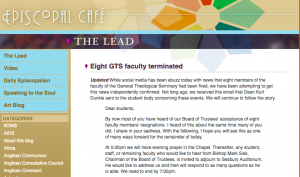http://www.episcopalcafe.com/lead/
 A letter from the Dean and President of General Theological Seminary was posted on EpiscopalCafe.com and then circulated on FB. Those interested in its contents are encouraged to find it there. For those who do not follow the news at religious institutions of higher learning, it should be enough to know that these institutions are experiencing the same traumas as publicly supported institutions of learning outside of the Church. Faculty in particular are in a bind. Shrinking revenues have led to layoffs, early retirement, broken contracts and the transition, everywhere, to the implementation of post-Fordist regimes of cultural production. And it is to these latter regimes, in large measure, that the faculty at General were responding when they went on strike. Many now have been let go. And that is tragic.
A letter from the Dean and President of General Theological Seminary was posted on EpiscopalCafe.com and then circulated on FB. Those interested in its contents are encouraged to find it there. For those who do not follow the news at religious institutions of higher learning, it should be enough to know that these institutions are experiencing the same traumas as publicly supported institutions of learning outside of the Church. Faculty in particular are in a bind. Shrinking revenues have led to layoffs, early retirement, broken contracts and the transition, everywhere, to the implementation of post-Fordist regimes of cultural production. And it is to these latter regimes, in large measure, that the faculty at General were responding when they went on strike. Many now have been let go. And that is tragic.
One interlocutor in the FB discussion, which is quite extensive, asks: “Why now?”
And it is to that question that, as an economist, I would like to respond. Briefly, like most institutions, the US Church also experienced its heyday in the immediate post-war period — that is World War II. The US economy was booming, had been booming since 1938, when, prior to entering the war, it began gearing up for full-scale war-time production. After the war, flush with capital and consumer goods, the US poured both into the recovering economies of Europe and Asia. Returning GI’s bought homes, went to college and got productive. Tuitions were at an all-time low. Registered students were at an all-time high. (It was in this climate that the Vatican promoted ecumenical dialogue and that the Graduate Theological Union, the most ambitious ecumenical and interreligious institution of higher learning, brought nine seminaries and, eventually, twenty-one independent research units together to offer its common core curriculum in collaboration with the University of California, Berkeley.) What could go wrong?
What went wrong is that eventually, in the late 1960s and early 1970s, Germany’s and Japan’s economies began to compete against the US economy globally; and this placed downward pressures on rates of profit. In order to maintain rates of return, investors initiated a full-court press to completely overhaul the fiscal, monetary, and regulatory climate globally. We call this regulatory dimension of the new economy “neoliberalism.” It is a term with which most of us are familiar. Far fewer are familiar with the term “post-Fordism,” which refers to the changed institutional and employment arrangements that accompanied neoliberalism. And, yet, we are probably familiar with many of its stock phrases: on-time delivery, flexible production, contingent workforce, off-shoring, down-sizing, sleek and efficient, “robust,” and so on. This new institutional regime is confusing. It replaces the large-scale, impersonal, inflexible bureaucratic model forged at the height of war, with a nimble, personal, flexible approach to production.
Some scholars with a less than adequate grasp of economic and social history may be inclined to mistake this transition for a new stage in ecclesiastical development, a new age of the spirit, free from buildings, institutions, churches, dogmas, liturgies and hierarchies. Since these scholars take their bearings from the seventeenth century, during which western Christian churches first became drunk on the extraordinary vitality, flexibility, and exuberance generated by nascent capitalism, they see the current post-Fordist Church as simply another natural progression in the same direction without ever reflecting critically about how this new spirit of capitalism infiltrated and transformed the Christian church. Such scholars are therefore inclined to celebrate the flexibility, openness, extra-institutional character of the post-Fordist Church. From an economic vantage-point, however, there is little to celebrate here. The highest rates of inequality in the modern epoch; little or no job security; and, as Thomas Piketty has reminded us in his best-selling Capital in the Twenty-First Century, a global economic system that is fundamentally unsustainable.
Theologically, however, the new institutional arrangements should also give us pause. Rather than celebrating our transition to distance learning, evening school, and weekend classes, we might instead call into question a social formation that has pushed all learning to the periphery compelling mom and dad to spend hours in front of their computers when they get home rather than spending time with their kids; that has transformed theological learning and in-residency training a luxury available to a small, hyper-wealthy, and hyper-young or retired elite; that has degraded and downgraded theological and religious vocations to the equivalent of the minimum-wage, non-benefited fast food clerk; and that celebrates the absence of an historical or institutional memory as evidence of God’s spirit among us.
Yet, following a by now familiar model, our seminaries packed their board rooms with men and women trained in business, law, and technology, cheerleaders all for the new post-Fordist economy. Why would they not transform our institutions to fit this new economy?
Why now? Now, because this is the direction that the entire global economy is moving, including our institutions of higher learning, including our seminaries and churches. Only if the Church were truly grounded in and guided by a different spirit would it have been in the forefront of the opposition to this movement. Instead, tragically, it is among its leadership; evidence, I fear, not of the spirit’s guidance, but of the spirit’s absence.
Comments are closed.